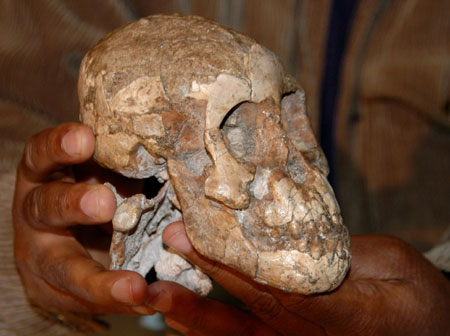LONDON - A 3.3 million-year-old skeleton of the earliest child ever found
shows the ancient ancestor of modern humans walked upright but may also have
climbed trees, scientists said on Wednesday.

A scientist holds a skull named
"Selam" of a fossil discovered in an area of Ethiopia called Dikika,
September 20, 2006. A 3.3 million-year-old skeleton of the earliest child
ever found shows the ancient ancestor of modern humans walked upright but
may have also climbed trees, scientists said on Wednesday.
[Reuters] |
They found the well-preserved remains of a three-year-old girl of the species
Australopithecus afarensis -- which includes the fossil skeleton known as "Lucy"
-- in the Dikika area of Ethiopia, 400 kms northeast of the capital Addis
Ababa.
"It represents the earliest and most complete partial skeleton of a child
ever found in the history of paeleoanthropology," said Dr Zeresenay Alemseged,
of the Max Planck Institute for Evolutionary Anthropology in Leipzig, Germany.
The skull, torso and upper and lower limbs, including the hand, show both
human and ape-like features. The state of the ancient bones suggest she was
buried in a flood which may also have caused her death.
The remains provide the first evidence of what babies of early human
ancestors looked like. The nearly complete skeleton will also provide
information about the child's height and structure.
"This child will help us understand a lot about the species to which it
belongs," said Alemseged, leader of the international team of scientists who
reported the findings in the journal Nature.
"The lower part of the body, which includes the foot, the shin bone and the
thigh bone clearly shows us that this species was an upright walking creature,"
he told Reuters.
But some of the features from the upper part of the body, including the
shoulder blade and arms are more ape-like. The fingers are long and curved which
suggest she might have been able to swing through trees.
"The finding is the most complete hominid skeleton ever found in the world,"
Zeresenay Alemseged, who is head of the Paleoanthropological Research Team, told
a news conference in Addis Ababa.
He said the fossil was older than the 3.2-million-year-old remains of "Lucy"
discovered in 1974 and described by scientists as one of the world's greatest
archaeological finds.
"The new bones belong to a three-year-old girl who lived 3.3 million years
ago, 150,000 years before Lucy," Zeresenay said.
The fossil has been named "Selam," which means peace in Ethiopia's official
Amharic language.
JUVENILE "LUCY"
Dr Simon Underdown of Oxford Brookes University in England described it as a
massively exciting discovery of a juvenile "Lucy." "This tremendous fossil will
make us challenge many of the ideas we have about how and why we came to walk on
two feet," he said.
An analysis of the sediment in which the remains were found enabled
researchers to build a picture of the type of environment in which the child
lived.
It was a lush area with flowing water, forests and grassland which was also
affected by volcanic eruptions. The range of habitats was suitable for hippos,
crocodiles and relatives of the wildebeest.
"We can see from the sediment that the region was very much characterized by
a mosaic of environment that ranged from forests and woodlands near the rivers,
to seasonally flooded grasslands to a flood plain that would have supported more
open vegetation," said Dr Jonathan Wynn of the University of South Florida who
dated the sediments surrounding the remains.